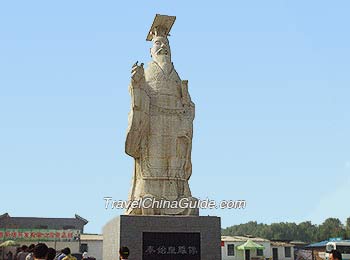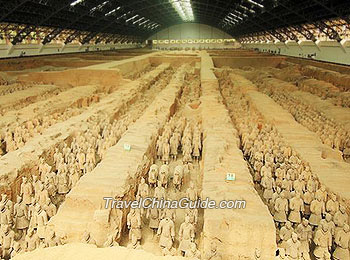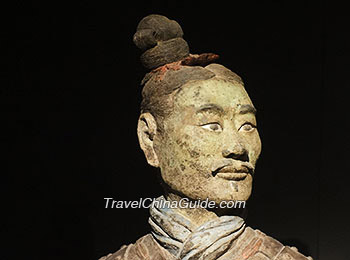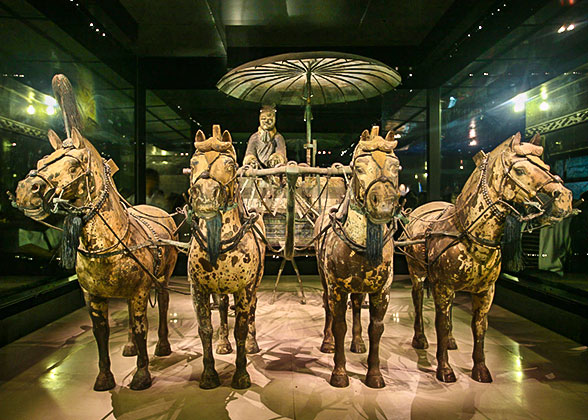10 Amazing Terracotta Army Facts You May Not Know
Terracotta Army Facts
![]() Chinese Name: 兵马俑 (Bīng Mǎ Yǒng)
Chinese Name: 兵马俑 (Bīng Mǎ Yǒng)![]() English Translation: Terracotta Army, Terracotta Warriors and Horses
English Translation: Terracotta Army, Terracotta Warriors and Horses![]() Location: 25 miles (40 km) northeast of Xi'an; 1 mile (1.5 km) east of the Mausoleum of the First Qin Emperor.
Location: 25 miles (40 km) northeast of Xi'an; 1 mile (1.5 km) east of the Mausoleum of the First Qin Emperor.![]() History: Over 2,200 years' history even before the unification of China.
History: Over 2,200 years' history even before the unification of China.![]() Construction Purpose: Funerary objects for Emperor Qin Shi Huang.
Construction Purpose: Funerary objects for Emperor Qin Shi Huang.![]() Scale: covering an area of 6.3 acres (25,380 square meters) with four pits in total. Figures were unearthed in three of them.
Scale: covering an area of 6.3 acres (25,380 square meters) with four pits in total. Figures were unearthed in three of them.
The Eighth Wonder of the World
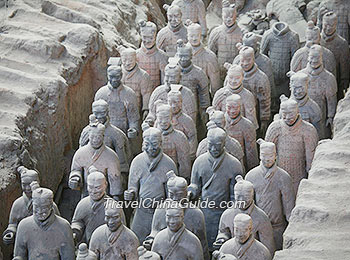 When the Xi'an Terracotta Army was discovered in 1974, this enormous sculpture group amazed the world. The pits were found to hold about 8,000 exquisite figures and horses, including burly generals, resolute military officers, and vivid soldiers. The find was praised as the Eighth Wonder of the World by the former French Prime Minister Chirac early in 1978, and became a UNESCO World Heritage Site in 1987.
When the Xi'an Terracotta Army was discovered in 1974, this enormous sculpture group amazed the world. The pits were found to hold about 8,000 exquisite figures and horses, including burly generals, resolute military officers, and vivid soldiers. The find was praised as the Eighth Wonder of the World by the former French Prime Minister Chirac early in 1978, and became a UNESCO World Heritage Site in 1987.
Over 2,200 Years' History
In 221 BC, a few years prior to the Roman Empire's engagement in the Second Punic War with Carthage, Alexander the Great's Greek Empire had fallen apart, and the Indian Maurya Dynasty had faded leaving south Asia divided and at war, a powerful and prosperous dynasty was established in central China. This was the Qin, the first period of entire unification of China. At that time, the dynasty was the most powerful state in the world with a population of 20 million and annual revenue worth 2,000 kilograms of silver. The powerful military and economic strength of the nation enabled the completion of such a great wonder - the huge funerary project with numerous terracotta warriors guarding the First Qin Emperor's mausoleum. This giant project was stopped and buried underground since 208 BC.![]() See more about History of Terracotta Army
See more about History of Terracotta Army
Who's the Owner of Terracotta Army?
Qin Shi Huang established the first centralized state of China and so became the first emperor of the entire country. Replicating the once invincible troops of the Qin Dynasty, the Terracotta Army was made with the glorious mission of protecting this great emperor in the underworld. However, some scholars hold the opinion that some facts show that the real owner of the pits might have been the Dowager Empress Xuan, the great-great grandmother of Qin Shi Huang. She was the mother of the King Zhao (306 - 251 BC) of Qin State and once controlled the court for 41 years. This bold conjecture advances the construction time of the project half a century earlier.![]() See more about Who's the Real Owner of the Terracotta Army?
See more about Who's the Real Owner of the Terracotta Army?
|
|
Huge Underground Military Formation with 8,000 'Warriors'
The determining factor of Qin State's transition from a small rather insignificant nation to the only power in the whole country was its strong army. The Xi'an Terracotta Army is a representation of the Qin State's troop formation with soldiers and chariots strategically arranged in the pits. About 8,000 warriors, 100 chariots, 400 horses, and more than 100,000 weapons have been unearthed from the three pits so far. To the front of the formation are three rows of crossbowmen able to launch a long-range attack. The main force formed by infantry and chariots follows after. On the two sides of this formation is the troop of cavalry designed to outflank the enemies.![]() See more about Military Formation, How many Terracotta Warriors are there in China?
See more about Military Formation, How many Terracotta Warriors are there in China?
Exhibits of the Museum in Three Pits
There are four pits in total, and from three of them terracotta figures have been unearthed.![]() Pit 1: It is the largest one with a length of 250 yards (230 meters) and a width of 68 yards (62 meters), equaling the size of two football fields. The military formation in it is made of chariots and infantry. There are over 6,000 individual figures and 50 chariots in total.
Pit 1: It is the largest one with a length of 250 yards (230 meters) and a width of 68 yards (62 meters), equaling the size of two football fields. The military formation in it is made of chariots and infantry. There are over 6,000 individual figures and 50 chariots in total.![]() Pit 2: It covers half size of the area of the Pit 1. This pit has the most army units with chariots, infantry, cavalry, and crossbowmen.
Pit 2: It covers half size of the area of the Pit 1. This pit has the most army units with chariots, infantry, cavalry, and crossbowmen.![]() Pit 3: It is the headquarters of the formations in the above two pits, with 68 figures, four horses, one chariot, and 34 weapons unearthed at present.
Pit 3: It is the headquarters of the formations in the above two pits, with 68 figures, four horses, one chariot, and 34 weapons unearthed at present.
Discovery of Terracotta Army by Farmers
Who found the Terracotta Army? One can hardly believe the fact that such important royal burial pits were accidently discovered by a group of famers, not archeologists. In March, 1974, several broken life-sized clay figures were found near Xi'an by nine farmers as they were digging a well, namely Yang Zhifa, Yang Peiyan, Yang Xinman, Yang Quanyi, Yang Wenxue, Yang Yanxin, Yang Yizhou, Yang Wenhai and Wang Puzhi. After the excavation, this grand underground military troop came to light again. Today, you can still see the founders in the museum, telling the story of the discovery and book signing.![]() See more about Who found the Terracotta Warriors?
See more about Who found the Terracotta Warriors?
Terracotta Soldiers are Taller Than Modern People
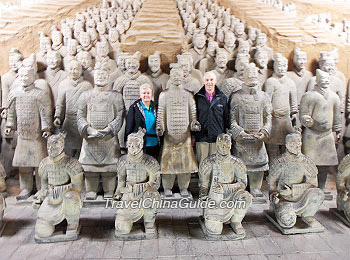 Facts from the excavation show that the Terracotta Warriors are generally 1.8-1.9 meters high, while the tallest is about 2 meters. The average height of all the warriors is 1.85 meters, which is taller than modern Chinese people. Does this mean people in the olden times were much taller? Some people don't think so. The terracotta soldiers were made much taller for two reasons. During that period, the major form of battle was close combat, which required tall and strong warriors. On the other hand, the taller terracotta warriors are a more impressive representation of the majesty of this once dominant army. But data from historical records and ancient human skeletons do show that ancient people are taller than modern people.
Facts from the excavation show that the Terracotta Warriors are generally 1.8-1.9 meters high, while the tallest is about 2 meters. The average height of all the warriors is 1.85 meters, which is taller than modern Chinese people. Does this mean people in the olden times were much taller? Some people don't think so. The terracotta soldiers were made much taller for two reasons. During that period, the major form of battle was close combat, which required tall and strong warriors. On the other hand, the taller terracotta warriors are a more impressive representation of the majesty of this once dominant army. But data from historical records and ancient human skeletons do show that ancient people are taller than modern people. ![]() See more about How tall are the Terracotta Warriors? Were ancient people taller than us?
See more about How tall are the Terracotta Warriors? Were ancient people taller than us?
Diverse Facial Features of the Soldiers
It is extremely difficult to find two similar figures in the three pits. Every soldier has his own facial features, which means there are 8,000 different faces in total. In fact, there were only eight moulds used to make the profile of each soldier's head. The 8,000 distinctive faces were carved by craftsmen individually, which definitely took massive amount of manpower. The excellent modeling skill of the Qin Dynasty artists is embodied in the vivid facial expressions created for each soldier.![]() See more about Faces of Terracotta Warriors
See more about Faces of Terracotta Warriors
The Figures Used to be Colorful
The figures always appear as grey in color. In fact, they were originally painted with black hair, beard, and eyebrows like real persons. Their uniforms were also painted in bright colors, including scarlet, green, black, and purple. The moist environment underground was more suited to the preservation of the paint. Once the figures were excavated, the change of the humidity led to more cracks and warping on the surface, and is the main factor resulting in the fading of the colors.![]() See more about True Colors of Terracotta Warriors
See more about True Colors of Terracotta Warriors
|
|
Bronze Chariots and Horses - King of Bronze Ware
Besides the clay sculptures, you can also see two sets of bronze chariots and horses in the museum. They were unearthed 20 yards (18 meters) west of the emperor's mausoleum in 1980. Before the excavation, they had already fallen into more than 1,000 pieces. It took eight years' renovation work to reproduce the original appearance of the chariots and horses. They are the largest and best preserved bronze chariots in China with a half size of the real imperial chariots of Qin Shi Huang. The first set weighs 1,061 kilograms with a length of 88.6 inches (225 centimeters) and a height of 59.8 inches (152 centimeters). The second one is of 124.8 inches (317 centimeters) in length and 41.7 inches (106 centimeters) in height, with a weight of 1,241 kilograms. Gold and silver were used to decorate the chariots and the accessories on the horses.![]() Further Reading:
Further Reading: ![]() What is the Terracotta Army? 10 Things You should Know
What is the Terracotta Army? 10 Things You should Know![]() 7 Cool Facts You May Not Know about the Terracotta Army
7 Cool Facts You May Not Know about the Terracotta Army![]() Why are the Terracotta Warriors Important?
Why are the Terracotta Warriors Important?![]() Why was the Terracotta Army built?
Why was the Terracotta Army built?![]() When was the Terracotta Army Built?
When was the Terracotta Army Built?![]() Where are the Terracotta Warriors Located?
Where are the Terracotta Warriors Located?![]() How to Repair the Damaged Terracotta Statues?
How to Repair the Damaged Terracotta Statues?![]() How to Potect the Terracotta Warriors?
How to Potect the Terracotta Warriors?![]() A Little-known Case of Terracotta Warriors Theft in 1987
A Little-known Case of Terracotta Warriors Theft in 1987![]() Ancient Greek Art Inspired China’s Terracotta Army? Impossible!
Ancient Greek Art Inspired China’s Terracotta Army? Impossible!![]() Terracotta Army Boosted the Rise of Modern Europe
Terracotta Army Boosted the Rise of Modern Europe![]() Stallions or mares are the war horses in the Terracotta Army?
Stallions or mares are the war horses in the Terracotta Army?![]() How did the Terracotta Army get burnt and destroyed?
How did the Terracotta Army get burnt and destroyed?![]() Why was there little record about Terracotta Warriors in history?
Why was there little record about Terracotta Warriors in history?![]() Where are the weapons used to be in Terracotta Warriors' hands?
Where are the weapons used to be in Terracotta Warriors' hands?![]() Were the Terracotta Warriors Made of Real Human Beings?
Were the Terracotta Warriors Made of Real Human Beings?![]() Recommended Tour Itinerary:
Recommended Tour Itinerary:
Terracotta Warriors Tour: One-day to visit Terracotta Warriors and Horses and more
More Xi'an Tours
![]() Next: History of Terracotta Army
Next: History of Terracotta Army
